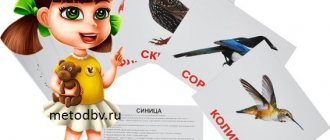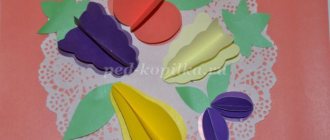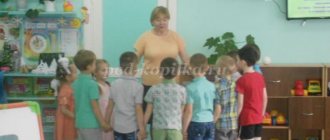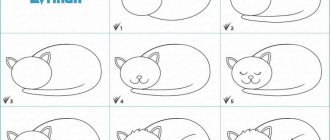Senior group. Senior preschool age. Children 5-6 years old
Photo report on GCD for modeling using the plasticine technique in the senior group on the topic “Fire extinguisher”
Preschoolers are little pioneers. The desire to constantly explore the world often confronts them with real dangers, and one of them is the threat of fire. During the school year, educators constantly work on fire safety: conversations using visuals...
Children's master class on plasticineography "Snowman" using cotton wool with children of senior preschool age
This master class will be of interest to preschool children and creative parents who want to spend interesting time with their children. Program tasks: - to arouse the desire in children to create a snowman using the technique of plasticine and cotton wool ; - continue to develop...
Club program "Plasticineography" Senior group
Municipal budgetary educational institution
"Kindergarten for care and health improvement No. 179"
Club program "Plasticineography."
Senior group
Accepted compiled At the pedagogical council, teacher of MBDOU No. 179 Babakekhyan A.G. Protocol No.____ dated _________2015
Kemerovo 2015 Explanatory note
Preschool childhood is a very important period in the life of children.
It is at this age that every child is a little explorer, discovering the unfamiliar and amazing world around him with joy and surprise. The more diverse children's activities are, the more successful the child's diversified development is, the more his potential capabilities and first manifestations of creativity are realized. That is why one of the closest and most accessible types of work in kindergarten is artistic manual labor, which creates conditions for involving the child in his own creativity, in the process of which something beautiful and unusual is created. I continue my “Crazy Hands” circle and want to introduce the children of the older group to an unconventional technique of visual arts - plasticineography
, the principle of which is to create a molded picture depicting semi-volume objects on a horizontal surface.
Relevance and novelty of the program:
is that the game situation introduces children to an unconventional technique of visual activity - plasticineography, which takes into account the age, physiological, psychological and cognitive characteristics of older children.
This work is aimed at developing fine motor skills of the fingers and hands. After all, at the moment the child is not sufficiently prepared to master the curriculum; many children have weakened fine motor skills of their fingers. During classes on this topic, children’s thinking, speech, perseverance are activated, and the ability to plan step-by-step work is formed. This is the pedagogical feasibility of this program. The main goal of the group work program: “Crazy Hands”: to teach children how to create objects using an unconventional fine art technique - plasticineography. The goal
is to instill aesthetic taste and awaken creative activity in students;
— acquaintance with a new type of application; — acquisition of knowledge, skills and abilities in making paintings from plasticine; - training in assembly and design of work. Objectives :
1. Master basic technological knowledge, skills and abilities.
2. Gain practical experience in creating crafts. 3. Know how to plan and organize leisure activities. 4. Use creative collaboration skills. Developmental:
promote the development of 1. creative abilities.
2. sensory skills, fine motor skills. 3. spatial imagination. 4. technical and logical thinking, eye. 5. ability to independently perform and create various crafts. Educational:
1. Respectful attitude towards the results of work.
2.Interest in creative and leisure activities. 3.Practical application of the rules of cooperation in collective activities. Basic forms and methods of work.
To achieve the goals, a selection of basic forms and methods of activity is provided.
A special place in the program is occupied by the following forms and methods of teaching: - reproductive (reproducing); - explanatory - illustrative (the explanation is accompanied by a demonstration of visual material); - method of problem presentation (the teacher poses a problem and, together with the children, looks for ways to solve it); — partially search; - practical. In conducting classes, both individual and group and collective forms of work are used. Children's age:
5 - 6 years.
Implementation period:
1 year.
Summarizing:
It is planned to organize children's work in the form of an exhibition, perform joint work by children, and report on the work done.
Development indicators
By the end of the school year, the child: - Masters the basic skills and abilities to sculpt objects of different shapes; — Create small plot compositions, conveying proportions, poses and movements of figures; - Develop perseverance; — Develops fine motor skills of the fingers — Maintains interest in the activity
Thematic planning
| № | Month | Topic of classes | Number of hours |
| 1 | October | Introducing children to plasticineography. Autumn leaves | 2 |
| Mushroom mushrooms grew in the forest | 2 | ||
| My garden and vegetable garden | 2 | ||
| Sovushka is an owl. Big head. | 2 | ||
| 2 | November | gold fish | 2 |
| Worm in the apple | 2 | ||
| Sperm whale - sperm whale | 2 | ||
| Octopus | 2 | ||
| 3 | December | Snowman | 2 |
| Christmas balls are so beautiful and important | 2 | ||
| Christmas tree | 2 | ||
| A white snowflake landed on my palm | 2 | ||
| 4 | January | Bullfinch | 2 |
| Penguin on an ice floe | 2 | ||
| Symbol of the year | 2 | ||
| 5 | February | A boat runs on the waves | 2 |
| Valentine card (heart) | 2 | ||
| Tie for dad | 2 | ||
| Apples on a plate | 2 | ||
| 6 | March | Flowers for mom | 2 |
| Matryoshka | 2 | ||
| Underwater kingdom | 2 | ||
| Snowdrop | 2 | ||
| 7 | April | Ladybug, fly to the sky | 2 |
| Butterfly | 2 | ||
| Magic egg | 2 | ||
| Swan | 2 | ||
| 8 | May | Bugs, worms and other insects woke up | 2 |
| Forget-me-nots | 2 | ||
| Dandelions | 2 | ||
| Fun Zoo | 2 |
Long-term plan
October.
- Subject:
Introducing children to plasticineography. Autumn leaves.
Target:
Conversation about plasticineography. The teacher demonstrates finished works using this technique, with the reflection of convex volumetric images on a horizontal surface. Introduce children to the concept of a stencil, show and teach how to work with it. Develop fine motor skills of the hand, develop color perception, the ability to choose the right tone of plasticine, graphic skills (the ability to work with a stack like a pencil, using the scratching technique); to cultivate aesthetic feelings through the perception of paintings by great artists about autumn, to lay the prerequisites for love of nature and a careful attitude towards it.
- Subject:
Mushroom mushrooms grew in the forest.
Target:
Improve skills in working with plasticine using the “plasticine drawing” technique - cutting with scissors, rubbing into shape. To form in children a generalized concept of mushrooms, their varieties, and qualities. Learn to find correspondences between the shapes of real and depicted mushrooms, to convey their natural features and color. Develop creative imagination and thinking; muscle activity of the arms. Cultivate accuracy in work, the desire to complete the work started with high quality and completion; feelings of collectivism.
- Subject:
My garden and vegetable garden.
Target:
Continue mastering the techniques of plasticineography - consolidate the technique of “rubbing” plasticine over the surface. Strengthen the ability to carefully use plasticine in your work. Learn to use contour drawing as the basis of an image. Strengthen the ability to classify fruits and vegetables. Develop hand motor skills, develop creative activity and independence; to evoke a desire to do a useful thing - a didactic game, to cultivate feelings of unity from the process of joint work.
- Subject:
Sovushka is an owl. Big head.
Target:
Learn to mix plasticine without allowing the colors to completely absorb each other.
Teach how to use a “rolling pin” - a tube of glue stick for rolling plasticine over a surface. Develop creativity, independence and activity. Develop fine motor skills when performing techniques for working with plasticine. Develop color perception. Cultivate diligence and perseverance in work, the desire to complete the work correctly and to the end. Foster honesty and criticality when evaluating “drawings”, teach how to prepare the background of the work (branch, moon, balls) November
- Subject:
Gold fish.
Target:
. Improve technical skills in working with plasticine. Develop imaginative perception, logical and creative thinking. Develop children's creativity through exposure to various methods and materials. Cultivate dedication and passion for creative work. Find out the desires and aspirations of children (with the help of a Goldfish).
- Subject:
A worm in an apple.
Target:
Carrying out work as a teacher using different modeling techniques. Strengthen the ability to carefully use plasticine in your work. Learn to use contour drawing as the basis of an image.
- Subject:
Sperm whale - sperm whale.
Target:
Continue mastering the techniques of plasticineography - consolidate the technique of “rubbing” plasticine over the surface. Strengthen the ability to carefully use plasticine in your work
- Subject:
Octopus.
Target:
Continue mastering the techniques of plasticineography - consolidate the technique of “rubbing” plasticine over the surface.
Strengthen the ability to carefully use plasticine in your work. Learn to use contour drawing as the basis of an image. Develop hand motor skills, develop creative activity and independence; to evoke a desire to do something useful, to cultivate a feeling of unity from the process of one’s work. December
- Subject:
Snowman.
Target:
To strengthen the ability to evenly and smoothly apply plasticine to the surface of cardboard - rub it using water. Learn to work using the grattage technique. To develop figurative perception, imagination and creative activity, independence in work, and graphic skills. Develop fine motor skills of the hand. Cultivate accuracy, independence, and decisiveness in actions.
- Subject:
Christmas balls are so beautiful and important.
Target:
To form in children a generalized idea of Christmas tree decorations: their history, traditions, types. Learn to create all kinds of scenery, plot images on the plane of an audio disc. Learn to use various aids for expressiveness and colorfulness of the image (caps from felt-tip pens, toothpicks). Develop children's creative imagination by encouraging them to come up with a pattern for their own ball. Foster a desire to contribute to the preparation of festive interiors and decorations.
- Subject:
Christmas tree.
Target:
Continue to introduce children to stenciling techniques and decorating techniques. Develop children's creative imagination and thinking when decorating the Christmas tree. Develop fine motor skills of the hands. Develop attentiveness, listening skills and following the teacher’s instructions. Arouse interest in the activity with a desire to participate in the preparation of festive events. Cultivate objectivity when evaluating the work of comrades.
- Subject:
A white snowflake landed on my palm.
Target:
Show the possibilities of using means uncharacteristic for this type of activity (garlic press) to embody the image.
Learn to make a geometrically correct drawing from plasticine passed through a garlic press. Develop eye, creative imagination and creative abilities. Arouse interest in the activity process. Cultivate accuracy and patience in the process of work. Develop the adequacy and reasoning of value judgments. January
- Subject:
Bullfinch.
Target:
Continue mastering the techniques of plasticineography - consolidate the technique of “rubbing” plasticine over the surface. Strengthen the ability to carefully use plasticine in your work. Learn to use contour drawing as the basis of an image. Develop hand motor skills, develop creative activity and independence; to evoke a desire to do something useful, to cultivate a feeling of unity from the process of one’s work.
- Subject:
Penguin on a piece of ice.
Target:
Continue mastering the techniques of plasticineography, preparing the background: waves - short blue sausages, the horizon line - a long white sausage, northern lights - multi-colored sausages laid out in rows in the form of lines.
- Subject:
Symbol of the year.
Target:
- Subject:
A white snowflake landed on my palm
Target:
Show the possibilities of using means uncharacteristic for this type of activity (garlic press) to embody the image.
Learn to make a geometrically correct drawing from plasticine passed through a garlic press. Develop eye, creative imagination and creative abilities. Arouse interest in the activity process. Cultivate accuracy and patience in the process of work. Develop the adequacy and reasoning of value judgments. February
- Subject:
A boat runs on the waves.
Target:
Improve the technique of working with plasticine. To teach children to independently choose techniques for depicting the sea (scratching, rubbing, decorating and rolling). Develop imaginative thinking and creative imagination. Activate fine motor skills of the hands. Learn to work with color; correctly build the composition of the drawing. Develop independence and individuality in work. Create a desire to give a gift to loved ones and dear people and congratulate them on the holiday “Defender of the Fatherland Day”. To cultivate love and respect for parents, pride in those who had to serve in the Army.
- Subject:
Valentine card (heart).
Target:
Improve your skills in using a stencil. Develop imaginative thinking and creative imagination. Activate fine motor skills of the hands. Learn to work with color; correctly build the composition of the drawing.
- Subject:
Tie for dad.
Target:
Encourage children to make gifts for loved ones. Develop creative imagination. Develop independent work skills.
- Subject:
Apples on a plate.
Target:
Introduce children to the concept of “still life”.
Invite them to independently compose a composition of three apples. Continue to teach how to reflect the natural features of fruits in visual activities: original shape and color. Develop eye and color perception. March
- Subject:
Flowers for mom.
Target:
Continue to introduce children to the options for using “plasticine products” of a garlic press. Learn to reflect the natural characteristics of the plant: the original shape and color of the petals. Continue to develop eye and color perception, composition, as well as fine motor skills of the hand. Make you want to give a gift to your loved one. Cultivate in children goodwill, kind, gentle relationships with loved ones (especially boys). Be careful when working with plasticine.
- Subject:
Matryoshka.
Target:
Introduce children to the world of art. Continue to teach decorating techniques: observe the geometry and symmetry of decorative elements, use colors correctly - choose contrasting colors. Develop fantasy, creativity, imagination, visual-figurative thinking, visual memory. Develop activity and independence in work, as well as diligence and accuracy.
- Subject:
Underwater kingdom.
Target:
Summarize children's ideas about the inhabitants of the underwater world. Continue to master the techniques of working with plasticine: consolidate skills in working with a stencil, select and successfully use visual materials, improve decorating techniques on the finished basis of the depicted object. Develop aesthetic and imaginative thinking and imagination. Develop creative activity and independence in work. To cause satisfaction from the process of your work and the result of the collective image of the marine world.
- Subject:
Snowdrop.
Target:
Continue to introduce children to the options for using “plasticine products” of a garlic press.
Learn to reflect the natural characteristics of the plant: the original shape and color of the petals. Continue to develop eye and color perception, composition, as well as fine motor skills of the hand. Make you want to give a gift to your loved one. Cultivate in children goodwill, kind, gentle relationships with loved ones (especially boys). Be careful when working with plasticine. April
- Subject:
Ladybug, fly to the sky.
Target:
To develop interest in the world around us and realistic ideas about nature. Learn to use knowledge and ideas about the features of the appearance of an insect. Continue to improve your skills in working with plasticine. Learn to listen to the teacher’s instructions and follow them in your work. Develop imaginative ideas and creative abilities. Develop skills in working with color. Develop resourcefulness in the process of completing a task: strive to use as many means as possible to embody the image. Cultivate diligence, perseverance, and the ability to finish what you start.
- Subject:
Butterfly.
Target:
Continue introducing children to the natural world.
Improve your skills in using the plasticine drawing technique. Strengthen the ability to roll short pieces and balls with your finger using circular movements. Stimulate the active work of the fingers. Develop creative thinking and imagination. Develop color perception, sense of harmony, sense of aesthetic perception. Topic:
Magic egg.
Goal:
To introduce children to a new image technique - “drawing with plasticine”, namely to teach decorating techniques with subsequent glossing. Inform and clarify children’s ideas about the reasons for the traditional celebration of Easter. Develop creative abilities. Develop activity and independence at work. Develop fine motor skills of the hand. Cultivate interest and a certain attitude towards spiritual values, towards the traditions of the people. To cultivate neatness, accuracy in work, and the desire to create a beautiful “drawing.”
- Subject:
Swan.
Target:
To develop interest in the world around us and realistic ideas about nature.
Learn to use knowledge and ideas about the features of the appearance of an insect. Continue to improve your skills in working with plasticine. Learn to listen to the teacher’s instructions and follow them in your work. Develop imaginative ideas and creative abilities. Develop skills in working with color. Develop resourcefulness in the process of completing a task: strive to use as many means as possible to embody the image. Cultivate diligence, perseverance, and the ability to finish what you start. May
- Subject:
Beetles, worms and other insects woke up.
Target:
Summarize the idea of insects. To develop the ability to work in a team amicably and accurately, creative and imaginative thinking of children. Encourage children's initiative and desire to add to the composition.
- Subject:
Forget-me-nots.
Target:
Continue introducing children to the natural world. Strengthen the ability to roll short pieces into balls with your finger using circular movements. Stimulate the active work of fingers
- Subject:
Strawberry.
Target:
Help expand children's knowledge about the diversity of plant species and forms. Strengthen cognitive interest in nature. Continue learning to create a composition from individual parts, achieving the integrity of the perception of the picture. Promote the development of formative hand movements when working with plasticine
- Subject:
Fun zoo.
Target:
Summarize children's ideas about the inhabitants of the zoo. Invite them to choose an animal themselves and draw it. Encourage independent activity. Design a thematic exhibition of works “Our Merry Zoo”
Conclusions
Let us remember that abilities are manifested and formed only in activity. This means that only by correctly organizing a child’s activities can one identify and then develop his abilities. K.D. Ushinsky wrote: “The basic law of children’s nature can be expressed as follows: a child needs activity incessantly and gets tired not of activity, but of its monotony or one-sidedness.” Thus, in activities aimed at achieving a specific goal, not only this activity itself is improved, but also the child’s visual perception of objects in the surrounding world. Productive activities contribute to the improvement of children’s speech, the formation of moral qualities of the individual, such as independence, initiative, organization and responsibility when completing a task. The effectiveness of the correction process during productive activities directly depends on the methods and techniques used in the work. According to scientists, it is advisable to carry out special work using natural materials.
Literature
- Sazhina D.S. “Drawing up working curricula for preschool educational institutions.” – “TC Sfera”, 2007.-112 p.
- “Moral and aesthetic education of a child in kindergarten” / Vetlugina N.A., Kazakova T.N., Panteleev G.N. – M.: Education, 1989. – 79 p.
- Komarova T.S., Savenkov A.I. “Collective creativity of preschoolers.” - M.: Pedagogical Society of Russia, 2005. - 128 p.
- “Collective creativity of preschool children” / Gribovskaya A.A. - “TC Sfera”, 2005. – 192 p.
- Doronova T.N. "Children's development in visual arts." – “CHILDHOOD-PRESS”, 2005. – 96s.
- Dubrovskaya N.V. "An invitation to creativity." – “CHILDHOOD-PRESS”, 2004. – 128s.
- Yakovleva T. N. “Plasticine painting.”—“TC SPHERE”, 2010.
- Lykova I.A. “We sculpt from plasticine, clay, dough” - “Olma Media Group”, 2009.







